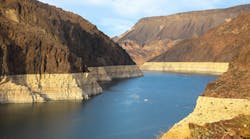About the author: Neal Shapiro is watershed management program coordinator for the Office of Sustainability and the Environment for the city of Santa Monica. Shapiro can be reached at [email protected].
Rainwater harvesting offers many important benefits, including reducing flooding and erosion; decreasing or eliminating combined sewer overflows (CSOs); reducing water pollution from storm water; and complying with various Clean Water Act regulations and permits. Another benefit is onsite and decentralized, or distributive, rainwater harvesting for non-potable direct beneficial use that replaces the use of potable water.
Most parts of the country are under regulatory orders to reduce polluted storm water flows entering receiving waters or to reduce storm water flows to reduce CSOs, which result in raw sewage spills. Generally, storm water management focuses on reducing storm water in the public rights-of-way, alleys and streets by detaining, treating and releasing storm water. Given the present critical water supply shortage in California and throughout the Southwest, and cycles of shortages in many other areas of the country, harvesting rain at its source can offer a supplemental water supply in place of a municipal or private well supply. Rainwater harvesting also is a low impact development (LID) solution, minimizing negative impacts on the environment and maximizing benefits.
Sustainable Practice
Onsite rainwater harvesting and direct use is one of many strategies in the city of Santa Monica, Calif.’s Watershed Management Plan and 2020 Sustainable Water Master Plan. This will help the city eliminate the use of imported water—which currently comprises about 30% of its water supply—making the city reliant on local water only. The city recently implemented two rainwater harvesting projects for non-potable, subsurface irrigation in lieu of using more valuable drinking water.
Last year, a new city library that uses rainwater for indoor flushing opened. The Pico Branch Library in Virginia Avenue Park was completed in the spring of 2014, in time to harvest enough rain to fill the 12,000-gal storage tank, and provide enough water to offset potable water use until mid-summer.
Rain that lands on the 13,250-sq-ft roof flows to a pretreatment device—a screen, spinning (vortex) and separation product that removes floatables, debris, heavier sediment and leaves. A storm event of up to 1 in. will result in 8,000 gal of harvested water. In an average year, the city has
13 in. of precipitation, allowing the library to harvest 104,000 gal. This amount of water can replace about 60% of the potable water that would have been used for indoor flushing annually. A larger tank could harvest enough water for 100% replacement, but the additional expense was high and the space required for such a storage tank was not available.
Pretreated rainwater then flows into the underground storage tank, which is under a fire lane. The tank has a recirculation system and spray nozzles that mix the water daily to prevent mosquito reproduction, as well as oxygenate the water to prevent it from becoming anaerobic. A number of utility covers provide access to different parts of the tank to service its various components and clean any residue not removed by the pretreatment devices.
Rainwater Treatment
From the storage tank, rainwater flows to the multistage treatment system: a sand filter and microfiltration cartridges that clarify the water and remove fine materials, and ultraviolet disinfection. Effective treatment is required not only to protect public health from microorganisms, but also to remove fine materials that could damage flushing equipment and invalidate flushing warranties. A secondary or residual disinfection device injects copper molecules as water flows through; copper molecules are an effective neutralizer of the bacteria and algae that may reside in the distribution pipe to the bathrooms. If necessary,
the rainwater also can be treated to drinking water quality with relative ease because the water is fairly clean
to begin.
Instead of treating the entire storage tank of water, which is inefficient, a 305-gal day tank stores treated water for on-demand use in the building. When a urinal or toilet is flushed, a pump on the treatment skid activates to draw treated water from the day tank to replace the water used for the flush. The day tank has its own pump to recirculate water back to the treatment train for additional treatment twice a day to maintain the high water quality; this also is a safeguard for longer periods (besides overnight) when the library is closed, and bacteria and algae could grow.
If the storage tank has insufficient water, a potable water makeup line brings municipal water to a T-connection after the day tank. The potable backup water does not go into the storage tank, as this water then would be needlessly double treated.
This project demonstrates how rainwater can be harvested on site for beneficial non-potable use in a building. This LID strategy promotes the use of local water resources and local self-sufficiency; reduces dependence on imported potable water, which benefits distant watersheds by keeping more water there; and reduces negative impacts from storm water, which carries numerous pollutants to Santa Monica Bay.
Download: Here


